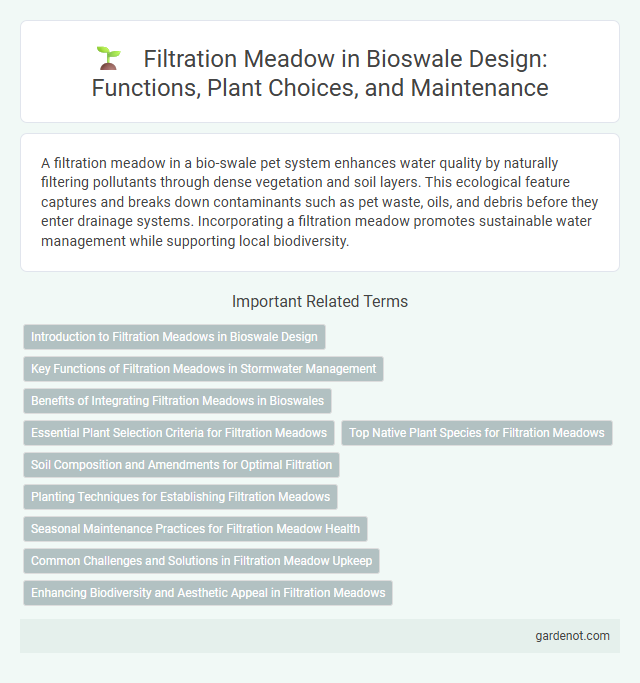A filtration meadow in a bio-swale pet system enhances water quality by naturally filtering pollutants through dense vegetation and soil layers. This ecological feature captures and breaks down contaminants such as pet waste, oils, and debris before they enter drainage systems. Incorporating a filtration meadow promotes sustainable water management while supporting local biodiversity.
Introduction to Filtration Meadows in Bioswale Design
Filtration meadows in bioswale design serve as natural water purification systems that enhance stormwater management by removing pollutants through soil and vegetation interaction. These meadows utilize dense planting of native grasses, sedges, and wildflowers to maximize infiltration and microbial activity, effectively filtering runoff before it reaches groundwater or nearby water bodies. Integrating filtration meadows into bioswales improves water quality, reduces erosion, and supports biodiversity within urban and suburban landscapes.
Key Functions of Filtration Meadows in Stormwater Management
Filtration meadows play a critical role in stormwater management by effectively capturing and filtering runoff through dense vegetation and engineered soil layers. These bio-swales reduce pollutants such as sediments, nutrients, and heavy metals before water infiltrates into the groundwater or discharges into local waterways. Their natural filtration process enhances water quality while mitigating flood risks and supporting urban ecosystem health.
Benefits of Integrating Filtration Meadows in Bioswales
Filtration meadows in bioswales enhance stormwater management by effectively removing pollutants such as nitrogen, phosphorus, and heavy metals through natural soil filtration and plant uptake. These ecosystems improve groundwater recharge and reduce surface runoff, mitigating flood risks while promoting biodiversity by providing habitats for native flora and fauna. Integrating filtration meadows increases the overall sustainability and efficiency of bioswales, contributing to healthier urban and suburban water cycles.
Essential Plant Selection Criteria for Filtration Meadows
Essential plant selection criteria for filtration meadows prioritize native species with deep root systems to enhance water infiltration and pollutant removal. Plants must tolerate varying moisture levels and support microbial communities critical for nutrient cycling. Species diversity improves resilience and maximizes the biofiltration capacity of the bio-swale ecosystem.
Top Native Plant Species for Filtration Meadows
Top native plant species for filtration meadows include Carex stricta (Tussock Sedge), Juncus effusus (Soft Rush), and Lobelia cardinalis (Cardinal Flower), which excel at nutrient uptake and sediment retention. These plants enhance bio-swale performance by stabilizing soil and promoting microbial activity that breaks down pollutants. Incorporating native grasses and wildflowers such as Echinacea purpurea and Asclepias tuberosa further supports biodiversity and water quality improvement in stormwater management systems.
Soil Composition and Amendments for Optimal Filtration
Filtration meadows rely on engineered soil compositions rich in organic matter, sand, and loam to maximize pollutant removal in bio-swales. Incorporating amendments such as compost and biochar enhances soil permeability and microbial activity, promoting effective filtration of stormwater contaminants. Proper soil texture and structure are critical to sustaining plant health while optimizing nutrient and sediment capture.
Planting Techniques for Establishing Filtration Meadows
Planting techniques for establishing filtration meadows in bio-swales emphasize selecting native grasses and wildflowers that enhance sediment capture and pollutant removal. Proper soil preparation, including grading and organic matter incorporation, ensures optimal root penetration and water infiltration. Strategic spacing and layering of diverse plant species promote a resilient ecosystem that maximizes filtration efficiency and supports local biodiversity.
Seasonal Maintenance Practices for Filtration Meadow Health
Seasonal maintenance practices for filtration meadows ensure optimal pollutant removal and plant health by scheduling tasks such as sediment removal, plant pruning, and replacement during dormancy periods. Regular inspection of inlets and outlets prevents clogging, while controlled mowing in late fall promotes nutrient cycling and encourages diverse native vegetation growth. Implementing adaptive management based on seasonal hydrology and vegetation changes enhances the functionality and longevity of filtration meadows within bio-swale systems.
Common Challenges and Solutions in Filtration Meadow Upkeep
Filtration meadows in bio-swale systems often face challenges such as sediment accumulation, clogged soils, and invasive plant species that reduce filtration efficiency. Implementing regular sediment removal, enhancing soil permeability through aeration, and employing native plant restoration effectively address these issues. Maintaining proper water flow and seasonal vegetation management ensures optimal pollutant removal and sustained ecosystem function.
Enhancing Biodiversity and Aesthetic Appeal in Filtration Meadows
Filtration meadows incorporate diverse native plants, creating habitats that significantly boost local biodiversity by supporting pollinators, birds, and beneficial insects. The strategic layering of grasses, wildflowers, and shrubs not only improves water filtration effectiveness by trapping sediments and pollutants but also enhances the visual appeal of urban or suburban landscapes. Integrating bio-swales within these meadows maximizes ecological benefits while contributing to sustainable stormwater management.
Filtration meadow Infographic

 gardenot.com
gardenot.com